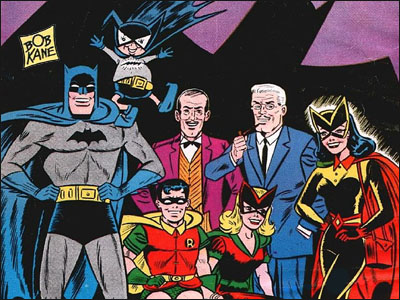This is Part Two of a multi-part article about how Batman changed forever, at least for me, on Thursday, March 26, 1964. If you haven't read Part One, go read Part One first.
As we all know, Bob Kane created Batman and drew every Batman story through the mid-sixties and no, I didn't even believe that when I was twelve. I had never heard of Bill Finger, the friend of Bob Kane's who wrote most of the early stories, particularly those that added new villains and other key elements of the Batman mythology.
I hadn't heard the names of any of the artists who really drew Batman then but I had a clue. I knew those stories weren't all by Bob Kane because there were different art styles. I thought, "He must have helpers" and I wondered which art style was really Bob Kane. It turned out none of them really were.
There was one style that looked an awful lot like the style of the guy who drew some of the Superman-Batman stories in World's Finest Comics but they weren't signed…by Bob Kane or anyone. If that was Bob Kane, the man who signed every Batman story, why wasn't he signing his Superman-Batman stories? And the same art style could be seen in the Supergirl stories in the back of Action Comics. If Bob Kane didn't have time to draw all the Batman stories, why would he anonymously be drawing Supergirl stories? Eventually, the artist began signing those Supergirl stories and I found out his name was Jim Mooney.
Here is how it worked. In the beginning, Bob's "studio" produced the art for Batman stories. Bob did a little of it, especially on the syndicated Batman newspaper strip. But he had a lot of assistants, all of whom drew better than he did, and he increasingly lost interest in sitting at the drawing board day and night, especially when someone else could be paid to do that.
He worked up a deal with DC Comics whereby "he" would supply a certain amount of Batman art per month. He would be paid so well for these pages that he could hire someone else to do all or most of the artwork on them and then he could live quite well off the rest of that compensation. DC didn't care. Much of what they published wasn't actually drawn by the guy they hired to draw it. Joe Shuster had an awful lot of help on Superman.
If DC wanted more Batman pages than the deal with Kane called for, DC was free to hire artists on their own — anyone as long as the art was signed "Bob Kane." The list of those artists included one of my favorites, Dick Sprang, along with Curt Swan, Winslow Mortimer, Jim Mooney and inker Charles Paris. The main guy who worked directly for Kane cranking out pages was Sheldon Moldoff but there was a period there when Lew Schwartz did the unsigned honors. Another of my favorites, Jerry Robinson, worked for Kane for a while and then for DC as did George Roussos.

By the early sixties, most of the Batman stories were penciled by Sheldon Moldoff for Kane with occasional jobs by Mooney or Sprang. Sprang retired in 1963. Charles Paris or Sheldon Moldoff did the inking. The art by then was not wonderful but I think the main problem was the scripts, which had gotten very silly. A lot of them involved Batman not fighting crime in Gotham City (i.e., the original premise of the feature) but battling space aliens, occasionally on other planets. There were two reasons for this…
One was that Batman had been hanging around a lot with Superman. As originally conceived in the forties, World's Finest Comics was a thick comic book that had room for a long story of Superman and a long story of Batman — DC's two big guns — and room for various back-up features. But as comics (and everything else) became more expensive to produce, comic books got smaller. In 1954 when they contracted from 64 to 32 pages, someone decided that rather than toss out more of the back-up features in World's Finest, they'd feature Superman and Batman together in one story instead of two separate ones.
When you appear with Superman, you're already fraternizing with someone from another planet. And when he's all-powerful and can fly and pick up Buicks, the stories have to be about some villain Superman can't defeat in three panels…or a crisis of interplanetary awesomeness. That means cosmic-scale menaces and lots of monsters and space aliens. So Batman was now in that world and a few years later, he wasn't just palling about with Superman…there was also the whole bloomin' Justice League of America.
So he was now a guy who fought mortal criminals in Gotham City and interacted with unworldly beings, be they friend or foe.
The other reason: The best-selling comics DC published were those that featured Superman and his featured players. The editor of those books, Mort Weisinger, liked to spend much time in editorial meetings boasting about his sales and suggesting he knew better than ever how to sell comics. And maybe he did just then with regard to the Man of Steel. But increasingly, Batman editor Jack Schiff felt pressure to make his comics more like Weisinger, even to the extent of emulating plot ideas and cover scenes.
The more sales on Batman and Detective Comics went down, the more they tried to do more of what was selling for Superman and the less Batman was Batman and…oh, it was not a good time for the Caped Crusader. Sales were falling and something had to be done. It was and in the next part, we'll discuss what was. I found it on a newsstand on 3/26/64.